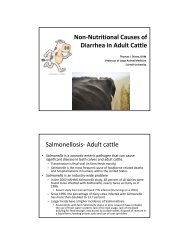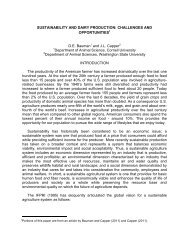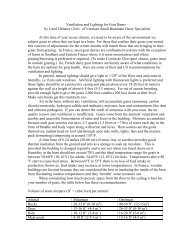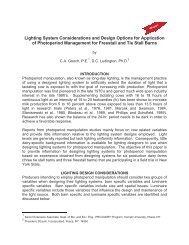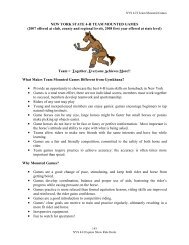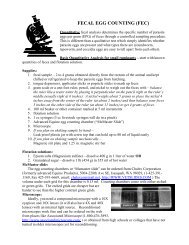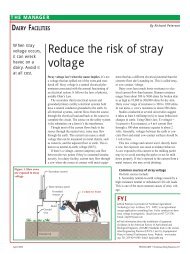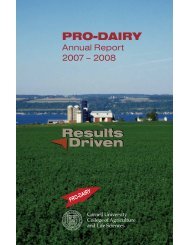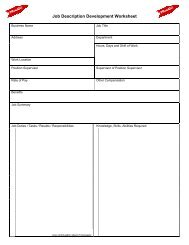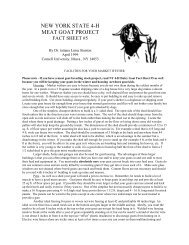2009 Proceedings of the Cornell Nutrition Conference For Feed ...
2009 Proceedings of the Cornell Nutrition Conference For Feed ...
2009 Proceedings of the Cornell Nutrition Conference For Feed ...
Create successful ePaper yourself
Turn your PDF publications into a flip-book with our unique Google optimized e-Paper software.
impact <strong>the</strong> AA pr<strong>of</strong>ile <strong>of</strong> metabolizable protein (MP) if o<strong>the</strong>r feedstuffs that are high in<br />
RUP-Lys are not included in <strong>the</strong> diet. These effects are fur<strong>the</strong>r confounded by <strong>the</strong> fact<br />
that RUP digestibility <strong>of</strong> DDGS is lower than corn meal, and RUP-Lys digestibility for<br />
DDGS is lower than <strong>the</strong> digestibility <strong>of</strong> <strong>the</strong> o<strong>the</strong>r AA (Boucher et al., <strong>2009</strong>a). Therefore,<br />
<strong>the</strong> inferior AA pr<strong>of</strong>ile <strong>of</strong> MP that results when feeding DDGS can be fur<strong>the</strong>r<br />
exacerbated by <strong>the</strong> decrease in digestibility <strong>of</strong> RUP and RUP-Lys. Decreases in milk<br />
protein concentrations have been reported when DDGS replaced corn meal and SBM in<br />
<strong>the</strong> diet <strong>of</strong> lactating cows (Kleinschmit et al., 2006) and when DDGS replaced wet<br />
distillers’ grains with solubles (Anderson et al., 2006). Therefore, assessing Lys due to<br />
<strong>the</strong> drying process <strong>of</strong> distillers grains is critical to <strong>the</strong> successful feeding <strong>of</strong> DDGS to<br />
lactating dairy cows.<br />
Monitoring Lys damage during <strong>the</strong> drying <strong>of</strong> blood meal (BM) is also critical. Blood<br />
meal obviously needs to go through a drying process before it is fed to cattle. The Lys<br />
concentration <strong>of</strong> BM is about 9% <strong>of</strong> CP (NRC, 2001), which makes BM a desirable<br />
ingredient to feed to increase Lys concentrations in MP (MP-Lys). However, if <strong>the</strong> Lys is<br />
damaged in <strong>the</strong> processing <strong>of</strong> BM, MP-Lys supply will be overestimated by current<br />
ruminant nutrition models. Therefore, understanding how heat processing conditions<br />
can impact <strong>the</strong> quality <strong>of</strong> protein feeds is critical, and developing methods to rapidly and<br />
accurately estimate <strong>the</strong> damage to Lys and protein that results from heat processing will<br />
be beneficial. More information regarding digestibility <strong>of</strong> RUP and RUP-AA, particularly<br />
RUP-Lys, is needed.<br />
Terminology<br />
NUTRITIONAL CONSEQUENCES OF HEAT PROCESSING<br />
In order to discuss <strong>the</strong> nutritional consequences <strong>of</strong> heat processing feedstuffs, <strong>the</strong><br />
following terms are defined:<br />
Bioavailability – proportion <strong>of</strong> ingested dietary AA that is absorbed in a chemical<br />
form that renders <strong>the</strong>se AA potentially suitable for metabolism or protein<br />
syn<strong>the</strong>sis.<br />
Digestibility – reflects enzymatic hydrolysis and microbial fermentation <strong>of</strong><br />
ingested proteins and peptides and absorption <strong>of</strong> AA and peptides from <strong>the</strong><br />
gastrointestinal lumen.<br />
Blocked lysine – lysine molecules in which <strong>the</strong> epsilon-amino group is bound to<br />
ano<strong>the</strong>r compound.<br />
Reactive lysine – lysine molecules in which <strong>the</strong> epsilon-amino group is not<br />
bound to ano<strong>the</strong>r compound.<br />
17



